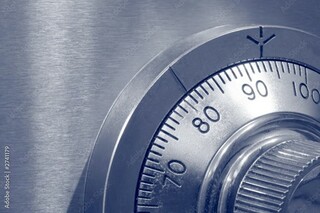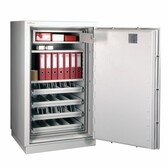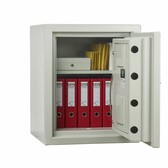The high awareness of the dangers caused by burglaries has made more and more people decide to buy a safe for their home. The most popular and popular safes are those with mechanical and electronic combination locks. Alongside these, there are also safes with key lock, biometric lock and smartphone opening. In this article you will find out which combination lock safe to choose.
Reliable safe with mechanical lock
A safe with a mechanical combination lock is considered to be faultless. It is opened with a code entered via a characteristic dial. The classic look and reliability make many people opt for this type of protection. A mechanical lock is one of the best security devices and does not need an additional key to open it.
Despite its many advantages, it also has its drawbacks. The biggest one is that it requires precision when entering the code. For a novice user, this can be cumbersome, but you quickly get the hang of it. Entering the code takes some time, as you have to make a sequence of several turns of the dial left and right.
If you are patient and do not have problems with hand trembling, you can opt for a safe with a mechanical lock. This solution is not recommended for the elderly and nervous people. If you don't need to open the safe often, opt for a traditional lock with a knob.
Opening a safe with a mechanical combination lock
A safe with a mechanical combination lock is equipped with two knobs. One of them is fixed and has two characteristic dashes on its upper part. The other – rotary – is used to enter the code and on its perimeter the digits from 0 to 99 are marked.
The left dash on the fixed knob is used to change the code, while the right dash is used to open the lock. To open a safe with a mechanical combination lock (having code 10-20-30-40, for example), do the following:
1. Turn the dial clockwise and align the number 10 with the right-hand dash on the fixed dial. Then turn clockwise four times, and after the last time, precisely align the number 10 with the right-hand mark.
2. Turn the dial counter-clockwise, aligning the number 20 with the right-hand dash on the fixed wheel. Now turn the dial counterclockwise three times, the last time, precisely align the 20 with the right-hand mark.
3. Turn the dial clockwise, aligning the 30 exactly with the right-hand mark. Now turn the dial clockwise two full turns, timing the 30 with the right-hand mark on the last turn.
4. Turn the dial counterclockwise and align the number 40 with the right-hand mark. Make one complete turn to the left, so that the number 40 is again precisely aligned with the right-hand dash.
5. Now simply turn the dial clockwise all the way and open the lock. You should see a number between 90 and 0 under the right-hand dash.
Remember to turn the dial evenly and slowly. The error limit is only 0.5 graduations. If you make a mistake, the whole operation will have to be repeated. To close the lock properly, turn the dial counterclockwise at least 5 times.
Operating a safe with a mechanical lock is not complicated, although it requires precision and calmness. Opening the armoured cupboard several times a day can be cumbersome, which is why this solution is chosen by people who use the safe only occasionally.
Read also: How to open a safe? Ways of opening different locks
An easy-to-use safe with electronic lock
Operating a safe with an electronic combination lock is definitely easier than precisely turning the dial on its mechanical counterpart. Here you simply use the numeric keypad to enter the code and finally confirm with enter.
Remember that the code can be very easily viewed by unauthorised people. An electronic lock is a good solution if the safe is frequently used by many people. Opening is much faster than with a mechanical lock.
The electronic lock requires power supply in the form of batteries. In the case of discharged cells in most locks, it is possible to apply external power. Some models require a key for emergency opening.
Which combination lock safe to choose?
Choosing a safe is an individual matter. Both mechanical and electronic safes are safe. Before making a purchase, consider what you want to keep in it and its value. Locks and safes have security classes. The more valuable things you want to keep in an armoured safe, the higher the security level of the safe and lock must be.
What else should I look for when choosing a safe?
When choosing a safe, it's worth paying attention to fire protection. Certified armoured safes have fire resistance classes in accordance with international standards. Buy a safe with a higher fire resistance class and you will protect your possessions not only from thieves, but also from fire.
The size of the safe is also an important consideration. Consider how many items and how big you want to protect. Invest in a larger one that will allow you to use and access your hidden items without any problems. A larger model will ensure that you can keep more valuables in it in the future.
Investing in a safe is the first step to ensuring your safety and peace of mind. Choose a model tailored to your needs. Remember to choose a lock that is easy to use. If combination models don't convince you, there is always the option of key or biometric security.
Read more about what to be aware of when changing the code on an electronic locking safe.





